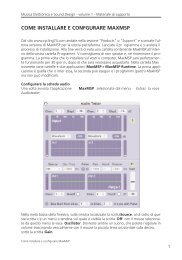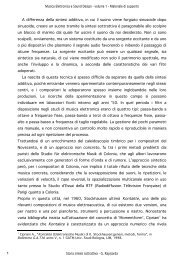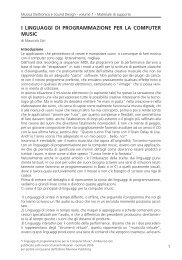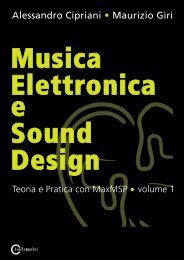programming with max/msp - Virtual Sound
programming with max/msp - Virtual Sound
programming with max/msp - Virtual Sound
Create successful ePaper yourself
Turn your PDF publications into a flip-book with our unique Google optimized e-Paper software.
IA1<br />
136<br />
Practice<br />
Paragraph IA.1 - Max and the numbers: the binary operators<br />
to the divider object have a decimal point as their last character, which declare<br />
that Max should use floating point operations. Also note the routing of the two<br />
patch cords that exit the float number box under the mtof object: one cord is<br />
connected directly to the saw~ object below it, but the second heads off to the<br />
right, heads upwards, and finally winds up connected to the multiplier object<br />
that has the argument 3.<br />
Fig. IA.9 The file IA_02_fifth.<strong>max</strong>pat<br />
If you compare Figures IA.6 and IA.9, notice that the frequencies calculated for<br />
the note a fifth above are different. By using two distinct mtof objects in the<br />
first patch, we calculated a tempered fifth (the fifth normally found in western<br />
music), which is defined as the interval formed by combining 7 tempered semitones.<br />
When we used the ratio 3/2 on the output of a single mtof, however,<br />
we calculated a natural fifth, which is slightly wider that a tempered fifth. The<br />
difference is around 2 cents (which is a unit defined to be 1/100 of a tempered<br />
semitone).<br />
OPERATIONS THAT USE THE EXCLAMATION POINT<br />
All of the operators spoken of so far are binary operators, so called because<br />
they need two inputs (also called operands in computer lingo) to produce their<br />
output. In the objects that we have already seen, the first operand is the number<br />
that is input on the left inlet and which triggers the operation, while the second<br />
operand is the argument (or else the number on the right inlet).<br />
For subtraction and division, however, there also exist two objects for which the<br />
operands are reversed. Their second operand is input on the left inlet and triggers<br />
the operation, while the first operand is the object’s argument.<br />
The name for these “reversed” objects is made up of an exclamation point plus<br />
the character for the underlying operation: !- for subtraction (which we have<br />
already encountered in patch 01_17_pan.<strong>max</strong>pat), and !/ for division.<br />
from “Electronic Music and <strong>Sound</strong> Design” Vol. 1 by Alessandro Cipriani and Maurizio Giri<br />
© ConTempoNet 2010 - All rights reserved







